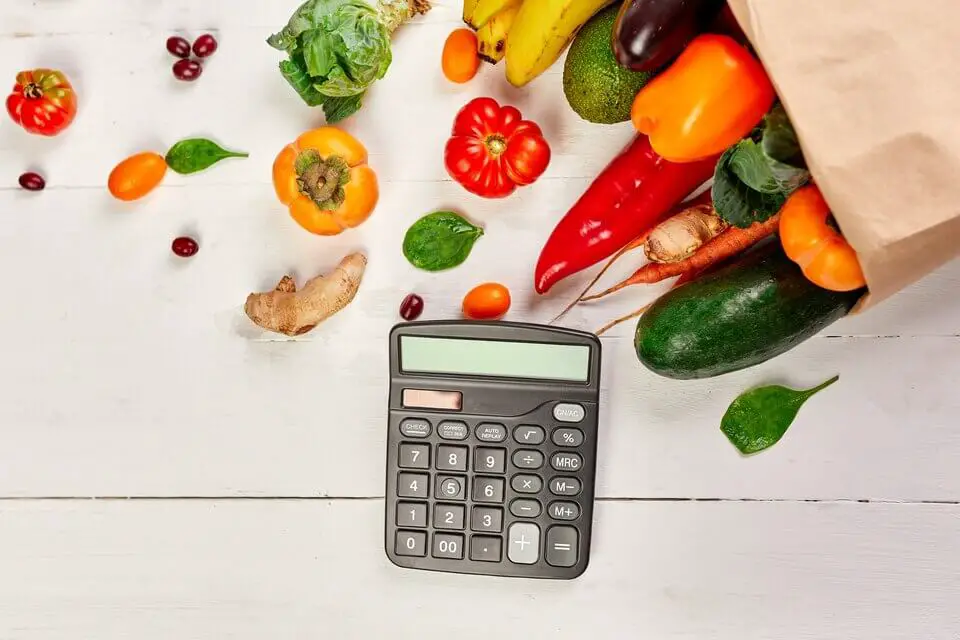
This post may contain affiliate links, please read our disclosure policy – Designed by Freepik.
Food expenses significantly impact every family’s budget, with the average household spending approximately $4,875 annually on groceries.
Regardless of whether you live to eat or eat to live, food costs account for a substantial portion of your monthly expenses. Reducing grocery bills can make a notable difference and help you save more quickly for that dream vacation.
However, cutting food costs isn’t always straightforward.
Whether you’re managing a tight budget or aiming to save between $200 and $500 a month, I’ve gathered some top tips to help you lower your grocery expenses.
With inflation surging at its highest rate in over four decades, food prices are a pressing issue.
While many expenses can be trimmed, eating is a necessity for everyone!
Here are my favorite strategies to manage your grocery spending effectively and still enjoy tasty, nutritious meals.
By following these practical tips, you can start saving hundreds or even thousands of dollars each year.
This post is all about the genuine ways on how to save money on groceries while shopping.
How To Save Money On Groceries & Cut Your Grocery Bill in Half
1. Plan Your Meals (Create a Food Budget).

Designed by Freepik
Planning your meals is key to reducing food costs for the whole family.
Create a meal plan for the upcoming 7 to 14 days, based on your shopping frequency. Include all meals—breakfasts, dinners, and lunches for work or school.
Identify the ingredients you’ll need for these meals. This helps avoid buying extra food “just in case.”
Meal planning allows you to assess the cost of each meal, enabling you to incorporate affordable, budget-friendly options and save money.
Evaluate whether you’re purchasing more groceries than necessary. Establishing a grocery budget helps you monitor and control your spending effectively.
2. Buy in Bulk.
Take advantage of bulk deals on items you frequently use. While this might stretch your budget temporarily, it leads to overall savings.
Knowing the lowest price of each product helps you spot a deal and act on it. For instance, if you use a lot of potatoes in winter, buying them in bulk when they’re discounted can be beneficial.
Avoid buying excessively to prevent food waste. Use up what you purchase to minimize spoilage.
I buy non-perishable items such as grains, legumes, and canned goods (like tuna) in bulk to save money. Be mindful not to over-purchase perishable goods.
3. Eat Before You Shop.
Shopping on an empty stomach can lead to impulsive buying of snacks and unnecessary items. Eat a substantial meal before heading to the grocery store.
A full stomach helps you stick to your shopping list and avoid overspending.
4. Shop at the Right Time.
The best time to shop is typically late in the evening, near closing time.
Fresh produce and meats are often discounted as vendors aim to sell off their stock for the day, offering you better deals on these items.
5. Use Free Gift Cards.
Who doesn’t enjoy freebies? Utilizing free gift cards can stretch your grocery budget.
Earn free gift cards through a FREE app like Swagbucks. It’s a great survey site that helps you save on groceries.
Sign up for a free Swagbucks account and earn points by completing surveys, watching videos, or shopping online. Exchange these points for gift cards to stores like Walmart, Kroger, and Meijer, effectively reducing your grocery costs.
6. Take Advantage of Expiry Offers.
Stores often offer significant discounts on items nearing their expiration dates. These deals are not for expired items but for products that need to be sold quickly before the expiry date.
You can find bargains like 3-for-the-price-of-1 on produce and meats up to 50% off. Use these items in your meal planning before they expire!
Check the clearance aisle for products with minor imperfections, which are often priced lower. Ensure that you avoid buying opened or compromised items.
This practice not only saves money but also helps reduce food waste.
Note: Buying items at a discounted rate is pointless if they end up being discarded shortly after.
7. Leave the kids at home / go to the store alone.
Parents, here’s a tip: taking your kids grocery shopping can nearly double your bill. They often ask for snacks, drinks, and other items not on your list.
This doesn’t mean you should never involve them in shopping—family time is valuable. However, to save money, consider leaving them at home and buying their treats separately.
Ask them if they want anything special before you head out, or surprise them later. This helps you stick to your shopping list and avoid unplanned expenses.
8. Buy seasonal.
Buying seasonal produce can be more cost-effective, healthier, and environmentally friendly.
Seasonal items are often cheaper because they require less transportation and artificial growth. They are harvested when they naturally thrive, which reduces production and transport costs.
If you’re unsure which items are in season, visit the Seasonal Food Guide to help you make informed choices.
9. Skip the impulse buys at checkout.
The items placed at checkout counters are designed to tempt you into making additional purchases.
Avoid these impulse buys by heading straight to checkout and home. This helps you stick to your budget and avoid unnecessary spending.
10. Organize your fridge.
An organized fridge can help you save money and reduce food waste.
To manage your food effectively, arrange items by their expiration dates: place those nearing expiration at the front and store longer-lasting items at the back. Check your fridge regularly and freeze items that are close to expiring but can’t be used immediately.
Freezing leftovers is also a great way to save. Prepare extra meals and freeze portions like soups, rice, or quinoa for later use.
11. Check unit prices.
Stores often hide the true cost of food. To find the best deals, always look at the unit price listed on the price tag.
Use a calculator to compare unit prices and determine the best value for your money.
12. Cook at home.
Cooking at home can be a game-changer. Here’s why:
- Healthier Options: Home-cooked meals are free from unhealthy fats, excessive salt, and sugar found in many ready-made meals.
- Cost Savings: Whole ingredients are typically much cheaper than dining out.
- Quality Family Time: Cooking together is a wonderful way to bond and enjoy a meal made with care.
13. Opt for generic brands.
Give store brands a try before dismissing them.
While they might seem like lower-quality options, many generic brands offer similar quality to name brands at a lower price. For example, Costco’s Kirkland paper towels are comparable to Bounty but often cost less.
Test out generic brands to see if they meet your expectations. If not, you can stick with brand names.
14. Try online grocery shopping.
Grocery delivery services can be a great way to save money and time.
Since I began using these services, I’ve noticed several benefits:
- Saves Time: No more wandering aisles or waiting in line. Use that time for things you enjoy.
- Reduces Fuel Costs: Eliminates the need for driving to the store.
- Reduces Impulse Buys: It’s easier to stick to your list when shopping online.
Consider trying services like Instacart or Amazon Fresh to see how convenient and cost-effective online grocery shopping can be!
15. Eat less meat.
Meat doesn’t have to be the centerpiece of every meal.
Reducing meat consumption can lower your grocery bill and improve your health. Try incorporating meatless meals into your weekly routine, such as veggie stir-fries or hearty salads, and gradually increase these meals.
You’ll find your grocery expenses drop and your overall well-being improve.
Consider affordable protein sources like eggs, tofu, or canned fish, and opt for conventional produce and whole fruits and vegetables.
16. Use coupons.
Coupons are a great way to save, even small discounts can add up.
To avoid letting coupons expire, make it a habit to regularly check for and use them. Keeping track of your coupons ensures you maximize your savings.
Pro Tip: Don’t forget to look through the Sunday newspaper for valuable coupons and discounts. You might come across buy-one-get-one-free offers on items you frequently purchase!
17. Download Grocery Apps.
Many retailers now offer apps that provide exclusive discounts and coupons. If you frequently shop at a specific store, downloading their app can be beneficial. You’ll gain access to special deals, coupons, and reward points that can be redeemed for cash savings on your groceries.
18. Check Your Receipt Every Time.
I’ve noticed that errors at checkout, such as incorrect charges or items scanned multiple times, can lead to lost money. To avoid this, I now review each receipt immediately after my purchase. Address any discrepancies while you’re still in the store to ensure you get any necessary refunds or corrections.
19. Utilize Leftovers.
To minimize food waste and save money, make a habit of using leftovers. Store them properly and incorporate them into your meals the following day. If you’re not in the mood for the same dish, freezing leftovers can be a great way to have a quick meal option later.
20. Earn Cash Back on Your Groceries.
Here are two popular apps for earning cash back:
Rakuten: Earn cash back on online purchases with over 2,000 retailers. Sign up today and receive a $10 welcome bonus.
Ibotta: Get cash back on numerous products at your favorite stores without needing coupons or points—just straightforward cash.
21. Simplify Dinner.
Dinner doesn’t need to be elaborate every night. Opt for simple meals like sandwiches, eggs with toast, or veggie-packed bowls. Keeping dinner uncomplicated can be just as nutritious and satisfying.
22. Avoid Eye-Level Products.
Stores often place their most expensive items at eye level. To find more budget-friendly options, check the top and bottom shelves, where cheaper brands are often located. This strategy can help you save on groceries.
23. Grow Your Own Produce.
If you have space, growing your own vegetables and herbs can be a cost-effective way to enjoy fresh produce. I particularly enjoy cultivating herbs like basil and thyme, which are often pricey in stores.
24. Skip Pre-Made or Pre-Cut Items.
Pre-prepped foods can be costly. Invest a few extra minutes to prepare fruits, veggies, and other foods yourself. It’s more economical and can be just as convenient with the right Tupperware.
25. Shop at Farmers Markets.
Farmers markets often offer better prices compared to grocery stores and provide the added benefit of supporting local farmers. Check out your local market for fresh and affordable produce.
26. Avoid Non-Grocery Sections.
Toiletries, cosmetics, and cleaning products are usually cheaper elsewhere. If you’re at a grocery store, it might be best to skip these sections and look for deals at wholesale clubs or discount stores.
27. Skip Bottled Water.
Bottled water is expensive and less eco-friendly. Instead, invest in a quality reusable water bottle and fill it from the tap. This will save you money and reduce plastic waste.
28. Set a Timer While Shopping.
Limit the time you spend shopping to avoid impulse buys. Stick to your list and aim to finish your shopping trip quickly to prevent unnecessary purchases.
29. Explore Extreme Budget Challenges.
Check out this video where Ardent Michelle takes on a challenge to eat for just $2 a day for a week. It’s an insightful look into managing a very tight grocery budget.
30. Prioritize Breakfast.
A hearty breakfast can help curb hunger and reduce the need for costly lunches. Try simple options like cereal, oatmeal, or eggs to start your day off right.
How To Plan Meals Using What You Have In The Fridge
For meal planning ideas, check out My Fridge Food. It allows you to input available ingredients and provides recipe suggestions, making meal planning easier and more efficient.
There You Have It: Clever Ways To Save On Grocery Shopping
By following these practical tips, you can significantly reduce your grocery expenses while still enjoying nutritious and delicious meals. With a bit of planning and strategy, saving on groceries is entirely achievable.
For additional tips on managing expenses and saving money, visit this related list.

Leave a Reply